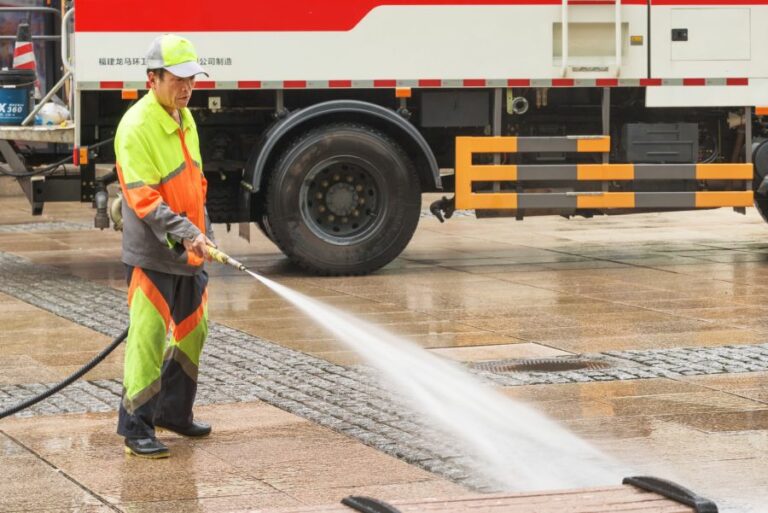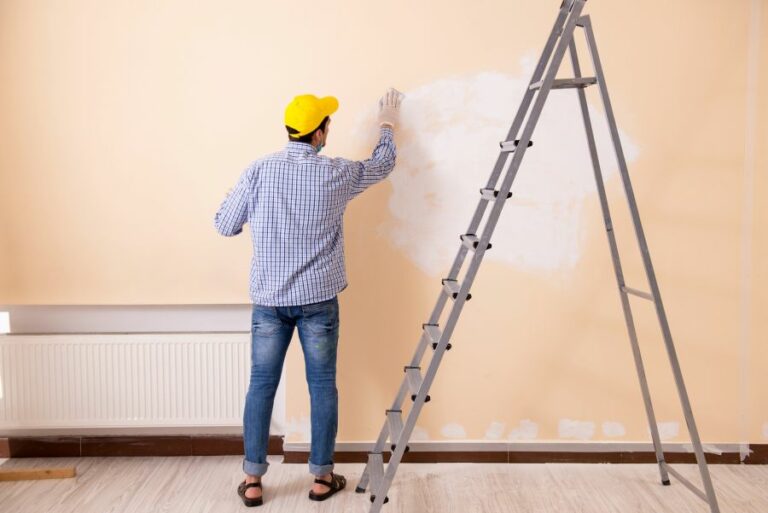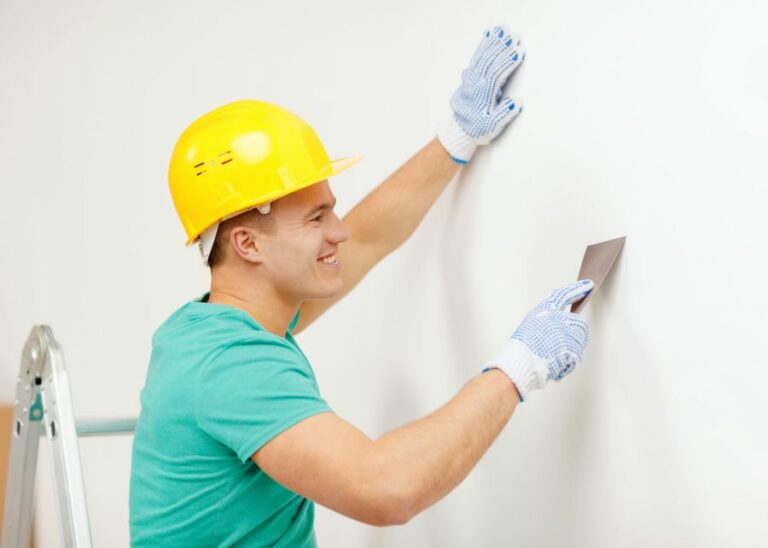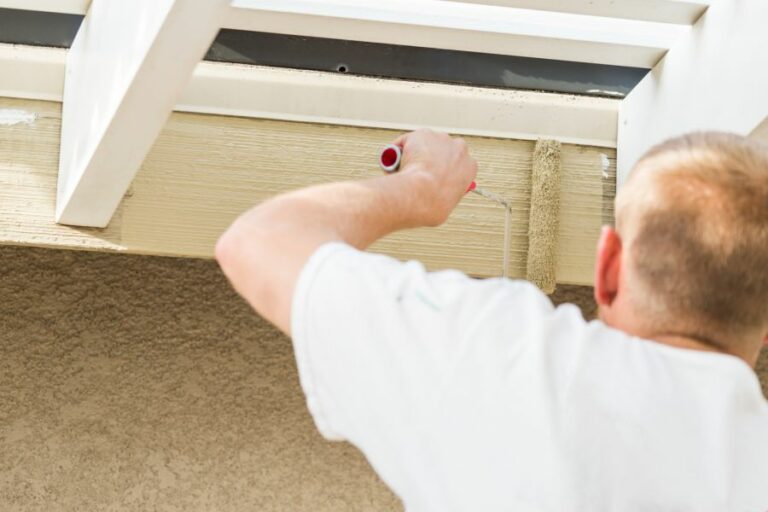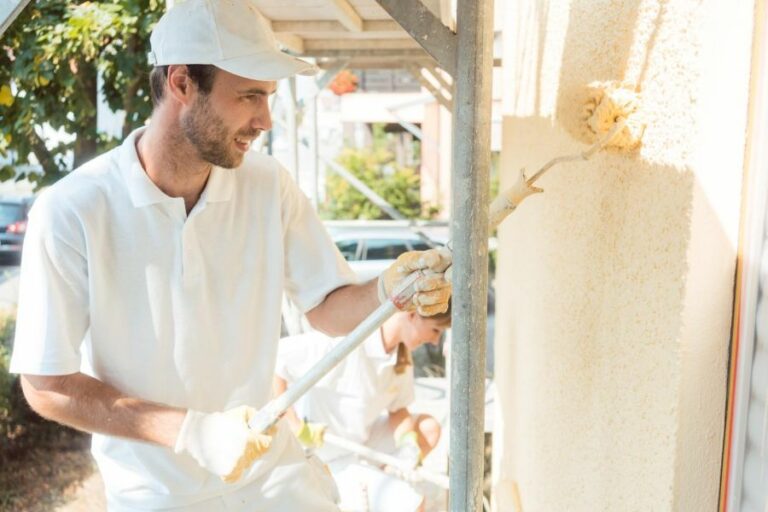Ambient Environment For Surface Prep Effectiveness
The effectiveness of surface preparation is directly influenced by the surrounding environment, and achieving optimal conditions is crucial for obtaining the best results. Our extensive experience in this field enables us to confidently guide you in creating the perfect ambient environment for surface prep effectiveness.
Ambient environment for surface prep effectiveness:
Optimal conditions for effective surface preparation include controlling factors such as temperature, humidity, ventilation, and particulate contamination. Recommended practices include using heating or cooling equipment, dehumidifiers, proper ventilation equipment, and air filtration systems. This ensures a strong, durable bond between material and substrate for coatings, paints, and adhesives.

Discover the crucial role of ambient environments in surface preparation effectiveness. Learn how factors such as humidity, temperature, and air quality impact the outcome and efficiency of various surface prep methods. Uncover valuable insights and tips to optimize conditions for desired results. Read on!
Contents
- 1 Optimal Conditions for Effective Surface Preparation
- 2 Ideal Temperature for Coating Application
- 3 Crucial Environmental Factors for Surface Painting Prep
- 4 Monitoring Atmospheric Conditions Prior to Coating
- 4.1 • Temperature: The Key to Ensuring Proper Coating Application
- 4.2 • Humidity: A Crucial Factor in Coating Drying and Curing
- 4.3 • Dew Point: Preventing Condensation during Coating Application
- 4.4 • Wind Speed: Ensuring Uniform and Contamination-Free Coating Application
- 4.5 • Following Recommendations and Ensuring the Right Conditions
- 5 Impact of Humidity on Surface Prep and Coating
Optimal Conditions for Effective Surface Preparation
• Importance of Surface Preparation
Surface preparation is a critical step in any coating, painting, or bonding process. Properly prepared surfaces result in a strong and durable bond between the material and the substrate.
The effectiveness of surface preparation depends not only on the selected method and materials but also on the ambient environment in which the preparation takes place.
• Temperature and its Impact on Surface Preparation
– Effects of Low Temperature
Low temperatures can significantly impact the effectiveness of surface preparation methods. For instance, when using chemical cleaning agents or solvents, low temperatures can cause the viscosity of the liquid to increase, reducing its ability to wet and penetrate the surface.
This ultimately leads to a less effective cleaning process.
In addition, if the temperature is below the dew point, condensation may form on the surface, leading to issues such as flash rusting or decreased adhesion of coatings. This can be particularly problematic in humid environments.
Recommendation: I recommend using heating equipment, such as infrared heaters, to maintain an appropriate temperature during surface preparation. Make sure to also check the manufacturer’s guidelines for temperature requirements specific to the cleaning agents or solvents being used.
– Effects of High Temperature
Surfaces that are too hot can also cause problems during surface preparation. High temperatures can lead to rapid evaporation of cleaning agents or solvents, resulting in streaks or uneven coverage.
Furthermore, high temperatures may cause the material applied to the surface (e.g., paint, coating, or adhesive) to dry too quickly, leading to poor adhesion and possible failure.
Recommendation: I recommend using cooling equipment, such as fans, to maintain an appropriate temperature during surface preparation. Alternatively, schedule the surface preparation process during the cooler hours of the day, or provide shade if working outdoors.
• Humidity and its Impact on Surface Preparation
Excessive humidity can have a significant impact on the effectiveness of surface preparation techniques. Moisture in the air can cause condensation on the surfaces being prepared, leading to complications such as flash rusting, decreased adhesion of coatings, and poor bonding.
Recommendation: I recommend using dehumidifiers to control the humidity levels during surface preparation. Additionally, ensure the substrate is completely dry before applying any coatings, paints, or adhesives.
• Ventilation and Air Quality
Proper ventilation is crucial for maintaining a safe and effective surface preparation process, particularly when using chemical cleaning agents or solvents.
Insufficient ventilation can lead to the buildup of hazardous fumes and vapors, increasing the risk of fire or explosion and exposing workers to potentially harmful substances.
Recommendation: I recommend using appropriate ventilation equipment, such as exhaust fans or air scrubbers, to ensure proper air exchange and maintain a safe working environment.
Additionally, consider using low-volatile organic compounds (VOC) or environmentally-friendly cleaning agents to reduce emissions and maintain air quality.
• Particulate Contamination
Airborne particulate matter, such as dust, sand, or debris, can compromise the effectiveness of surface preparation by settling on the cleaned surface before the application of the coating or adhesive.
This can lead to poor adhesion, decreased durability, and an overall reduction in the quality of the finished product.
Recommendation: I recommend using air filtration equipment, such as dust collectors or air purifiers, to minimize particulate contamination in the work area.
Additionally, implementing proper housekeeping practices, such as regular cleaning and providing proper storage for materials and equipment, can help maintain a clean and contaminant-free work environment.
• Conclusion
Taking the ambient environment into account when conducting surface preparation is essential for ensuring optimal results.
By controlling factors such as temperature, humidity, ventilation, and particulate contamination, you can maximize the effectiveness of surface preparation methods and achieve a strong, durable bond between the material and substrate.
Ideal Temperature for Coating Application
• Introduction
The ambient temperature is an essential factor to consider when applying a coating. It influences many aspects of the process, such as the curing time, flow, and overall performance of the coating.
• Ambient Temperature: The Basics
The ambient temperature refers to the temperature of the surrounding environment. For most coatings, especially those that rely on chemical reactions for curing, temperature plays a significant role in determining how well the coating will adhere, cure, and perform.
To ensure a high-quality finish, it is essential to apply coatings within their recommended temperature range.
– Why is Ambient Temperature Important?
Several reasons make the ambient temperature crucial for the coating process:
- Temperature affects the coating’s viscosity: At lower temperatures, coatings typically become more viscous, making them harder to apply. Conversely, at higher temperatures, coatings become less viscous, which can lead to runs and sags.
- Temperature affects the curing time: The curing time for various coatings relies heavily on the ambient temperature. Low temperatures will slow down the curing process, while high temperatures will speed it up. In some cases, excessively high temperatures can lead to uneven curing or even cause the coating to fail.
- Temperature affects the coating’s performance: Applying a coating outside of its recommended temperature range can result in poor adhesion, inadequate film thickness, and other issues affecting the coating’s performance and durability.
• Ideal Ambient Temperatures for Common Coatings
– Epoxy Coatings
Epoxy coatings are widely used for various applications, from industrial flooring to protective coatings for metal surfaces. The ideal ambient temperature for applying epoxy coatings typically ranges from 50°F (10°C) to 95°F (35°C).
Colder temperatures will slow down the curing process, while higher temperatures can cause bubbles to form and may lead to a shorter pot life (the time available to use the mixed epoxy).
– Acrylic and Latex Coatings
Acrylic and latex coatings are commonly used in architectural and decorative applications. The optimal ambient temperature for applying these coatings is generally between 50°F (10°C) and 85°F (29°C).
Lower temperatures can cause the coatings to thicken, making them more challenging to apply, while higher temperatures can lead to faster drying and a lower open time (the period during which the coating can be applied and reworked).
Moreover, applying acrylic or latex coatings in cold temperatures may result in reduced adhesion and poor film formation.
– Polyurethane Coatings
Polyurethane coatings offer exceptional durability and resistance to abrasion, making them suitable for various industrial and automotive applications. The ideal ambient temperature for polyurethane coatings ranges from 60°F (16°C) to 90°F (32°C).
Applying polyurethane coatings outside of this temperature range may affect the coating’s viscosity and cure rate, leading to poor adhesion, reduced durability, and an uneven finish.
• Tips for Achieving the Ideal Ambient Temperature for Coating
– Plan Ahead
Monitor the weather forecast and select a date with suitable temperatures for the coating process. This is especially important when working on outdoor projects that are subject to changing weather conditions.
– Adjust the Coating’s Formulation
In some cases, it may be possible to adjust the coating formulation to suit the ambient temperature. Consult the coating manufacturer for guidance and additives that can help adapt the coating for the desired application conditions.
– Control the Environment
When working indoors, ensure that the room temperature is maintained within the recommended range. Use heaters or air conditioners as needed to achieve the desired ambient temperature.
Additionally, make sure that the substrate (the surface being coated) is also within the recommended temperature range, as this can significantly affect the coating’s adhesion and performance.
– Take Precautions
When applying coatings in challenging temperature conditions, be prepared to adjust application techniques, equipment, and other factors to accommodate the environment.
For example, use thinner coats and increase drying times when working in colder temperatures or use specialized equipment designed for high-temperature applications.
• Conclusion
Understanding the importance of ambient temperature and ensuring that coatings are applied within their recommended temperature range play a crucial role in achieving a successful, high-quality finish.
By paying close attention to temperature considerations and making necessary adjustments, professional applicators and DIY enthusiasts alike can ensure that their coating projects are durable, functional, and visually appealing.
Crucial Environmental Factors for Surface Painting Prep
In this article, we will discuss the essential environmental requirements for the preparation of new surfaces before painting.
These factors are crucial to achieving the desired results on any painting job, be it residential or commercial. The factors include surface temperature, humidity, dew point, and air temperature, among others.
• Surface Temperature
Surface temperature plays a significant role in achieving proper paint adhesion and preventing paint-related issues such as blistering and peeling.
Before painting, it is crucial to measure the surface temperature and ensure it is within the recommended range for your particular paint product.
As a rule of thumb, the surface temperature should be at least 5 degrees Fahrenheit above the dew point and below 90 degrees Fahrenheit.
I recommend using an infrared thermometer to accurately measure the surface temperature. Another tip is to avoid painting in direct sunlight, as it can markedly increase the surface temperature and adversely affect the paint’s performance.
• Humidity and Dew Point
Relative humidity and dew point are equally essential factors to consider when preparing new surfaces for painting. These environmental factors can impact paint drying times, adhesion, and the overall quality of the paint finish.
The ideal relative humidity for painting ranges from 40% to 70%. High humidity can lead to increased drying times and potential adhesion problems, while low humidity can cause the paint to dry too quickly and may result in uneven application.
To calculate the dew point, you can use a psychrometer, digital weather station, or an online dew point calculator. The dew point is critical because if the surface temperature goes below this value, condensation can form on the surface, leading to poor adhesion and other paint defects.
In most instances, it is advisable to start painting in the morning to take advantage of lower humidity levels and avoid the risk of dew forming on the surface.
• Air Temperature
Air temperature is another essential environmental factor you need to consider when preparing new surfaces for painting. The temperature affects not only the drying time of paint but also the ease of application.
Paint manufacturers generally recommend an application temperature range of 50 to 90 degrees Fahrenheit. Keep in mind that air temperature should be consistent for at least 48 hours before and after application to allow for proper curing of the paint film.
For optimal results, always refer to the paint manufacturer’s guidelines on the product label for temperature and weather recommendations.
• Ventilation and Airflow
Adequate ventilation and airflow are vital when painting indoors. Proper airflow ensures that paint fumes dissipate quickly, reducing the risks associated with inhaling volatile organic compounds (VOCs) and paint odors.
To achieve sufficient ventilation, open windows and doors, and use exhaust fans if available. Positioning a fan near the painted surface can also be helpful to promote even drying and prevent condensation, especially in areas with high humidity.
Take extra precautions and use protective equipment, such as masks with appropriate filters, when working with products containing higher VOC levels.
• Conclusion
Preparing new surfaces for painting is critical to achieving a durable and attractive paint finish. The environment plays an essential role in determining the success of your painting job.
By paying close attention to environmental factors such as surface temperature, humidity, dew point, air temperature, and ventilation, you can ensure proper adhesion, surface preparation, and a high-quality paint finish.
Remember, always refer to the paint manufacturer’s guidelines on product labels for specific environmental requirements and adhere to best practices to guarantee the success of your next painting project.
Requirement | Description |
|---|---|
Temperature | Optimal temperature for surface preparation and painting is typically between 50-85 degrees Fahrenheit (10-29 degrees Celsius). Painting in extreme temperatures can cause the paint to dry too quickly or not adhere properly. |
Humidity | It is recommended to work in conditions with a relative humidity between 40-70%. High humidity can prevent paint from drying properly, while low humidity can cause the paint to dry too quickly. |
Ventilation | Proper ventilation is necessary during surface preparation and painting to promote even drying and to remove harmful fumes from the work area. Use fans or open windows to maintain adequate air circulation. |
Surface Cleanliness | The surface should be clean and free of dust, dirt, grease, and debris. Use pressure washing, sanding, or other cleaning methods to ensure a clean and smooth surface prior to painting. |
Surface Dryness | Ensure the surface is completely dry before applying paint. Painting on wet or damp surfaces can lead to poor adhesion and bubbling or peeling paint. |
Monitoring Atmospheric Conditions Prior to Coating
Coating application is a crucial process in various industries, including construction, automotive, and aerospace. To ensure the best possible results, it’s essential to monitor the atmospheric conditions before applying the coating.
Some of the critical atmospheric conditions include temperature, humidity, and dew point. These variables play a significant role in determining the adhesion, cure time, and overall performance of the coating.
The following discussion provides a comprehensive overview of what atmospheric conditions to monitor before coating application.
• Temperature: The Key to Ensuring Proper Coating Application
Temperature is a critical variable that significantly affects the coating application process. It influences the coating’s viscosity, drying time, and overall adhesion to the substrate. Monitoring the ambient temperature and the surface temperature of the substrate before applying the coating is essential.
– Ambient Temperature
Ambient temperature refers to the temperature of the surrounding air. For optimal coating application, it is generally recommended that the ambient temperature should be between 50°F (10°C) and 100°F (38°C).
It is essential to consider that different coatings may have specific temperature requirements. Therefore, always refer to the coating manufacturer’s guidelines for the ideal ambient temperature range.
– Surface Temperature
The surface temperature of the substrate is equally critical. It should be within the recommended range provided by the coating manufacturer. A temperature outside the recommended range can lead to poor adhesion and premature failure of the coating.
To measure the surface temperature, you can use an infrared thermometer or a surface temperature probe.
• Humidity: A Crucial Factor in Coating Drying and Curing
Humidity refers to the amount of moisture present in the air. High humidity can pose issues to the coating application process, as the presence of moisture can prevent the coating from drying or curing adequately.
Conversely, low humidity may lead to rapid evaporation of solvents, which can result in poor leveling and a rough finish. It is imperative to monitor humidity levels to ensure a successful coating application.
Relative humidity (RH) is the ratio of the actual moisture content in the air compared to the maximum amount of moisture the air can hold at a given temperature.
Relative humidity of 85% or lower is generally recommended. However, certain coatings may have specific humidity requirements. Always consult the manufacturer’s guidelines for the recommended RH range.
A psychrometer or a digital hygrometer can be used to measure the relative humidity at the application site.
• Dew Point: Preventing Condensation during Coating Application
The dew point refers to the temperature at which moisture in the air condenses into water. When the surface temperature of the substrate is below or close to the dew point, condensation may occur on the substrate.
This can lead to several problems, including poor adhesion, blistering, or a weakening of the coating.
To prevent these issues, the surface temperature of the substrate should typically be at least 5F (3C) above the dew point. Measuring the dew point can be done using a sling psychrometer or a digital hygrometer with dew point measurement capabilities.
• Wind Speed: Ensuring Uniform and Contamination-Free Coating Application
Wind speed can have an impact on the coating application, particularly when spraying the coating. High wind speeds may cause overspray, leading to uneven coating or contamination of surrounding areas.
In general, wind speeds of 10 mph (16 km/h) or lower are recommended for most coating operations. Anemometers are useful tools for measuring wind speed at the application site.
• Following Recommendations and Ensuring the Right Conditions
It is crucial to note that the optimal atmospheric conditions may vary depending on the specific coating material to be applied. Always refer to the manufacturer’s guidelines for the recommended application conditions.
By closely monitoring and ensuring the right atmospheric conditions, you can significantly improve the overall success of your coating application project.
For more information on best practices and guidelines related to coating application, visit the SSPC: The Society for Protective Coatings website.
Condition | Description |
|---|---|
Temperature | Check the surface temperature, air temperature, and dew point. Ensure they are within the specified range for the coating material. |
Humidity | Measure the relative humidity and make sure it is within the acceptable range specified by the coating manufacturer. |
Moisture | Inspect the surface for any signs of moisture, such as wetness or condensation. Surfaces should be dry prior to coating application. |
Wind Speed | Ensure that wind speeds are moderate and within the recommended range, as strong gusts can affect the spray application and drying process. |
Dew Point | Make sure the surface temperature is at least 3°C (5°F) above the dew point for optimal adhesion and curing. |
Surface Preparation | Confirm that the surface has been properly cleaned, dried, and prepared (e.g., abraded or roughened) according to the coating manufacturer’s guidelines. |
Surrounding Environment | Monitor the presence of dust, debris, or other contaminants in the surrounding environment that could potentially affect the coating application process. |
Impact of Humidity on Surface Prep and Coating
Surface preparation and coating application are critical steps in the industrial painting process and other fields, such as construction and automotive manufacturing.
Understanding the effect of humidity on these processes is essential to ensure the successful adhesion of the coating and the quality of the final product.
• The Role of Humidity in Surface Preparation
Humidity refers to the amount of moisture present in the surrounding air. During surface preparation, this moisture can negatively impact the process in several ways. One significant effect of high humidity on surface preparation is the formation of surface contaminants.
– Formation of Surface Contaminants
When humidity levels are high, moisture can condense on the surface, leading to the formation of rust, mill scale, and other contamination. These contaminants can impair the adhesion of the coating and lead to premature coating failure.
To avoid this issue, it is crucial to control the humidity in the work area and ensure thorough cleaning of the substrate before applying the coating.
– Impact on Abrasive Blasting
High humidity can also impact the effectiveness of abrasive blasting, a common technique used for surface preparation. Moisture in the air can cause abrasive particles to clump together, reducing their efficiency in removing contaminants.
Additionally, moisture can hinder the visibility of the operator, making it challenging to achieve a consistent surface profile. To prevent these issues, ensure that the abrasive materials are dry and consider using air dryers or dehumidifiers to control the air’s moisture content.
• The Influence of Humidity on Coating Application
Coating application involves the deposition of a thin film of material onto a surface, which serves as a protective or decorative layer. The effect of humidity on this process can lead to numerous issues, such as poor adhesion, micro-bubbling, and compromised coating quality.
– Poor Adhesion
High humidity can affect the adhesion of a coating to the surface, particularly in the case of waterborne paints. When there is excess moisture in the air, the paint can absorb this moisture, causing the paint film to swell.
This swelling can interfere with the proper bonding of the paint to the surface, resulting in poor adhesion and, ultimately, premature coating failure.
– Micro-Bubbling
Humidity can also cause micro-bubbling in the coating. When a coating is applied in high-humidity conditions, moisture can become trapped within the applied film. As the coating cures, the moisture can create tiny bubbles that may weaken the integrity of the film and impact its appearance.
To prevent this issue, avoid painting when humidity levels are too high or use coatings designed specifically for high-humidity conditions.
– Compromised Coating Quality
Aside from adhesion and micro-bubbling, high humidity can also impact the overall quality of the coating. High humidity levels may slow down the resistance of water-based paints, potentially leading to uneven film thickness, reduced gloss, or discoloration.
High humidity can also impact solvent-based paints, as the excess moisture can cause the solvents to evaporate too slowly, resulting in a longer drying time.
This extended drying period can leave the coating more susceptible to contamination, such as dust or insects, which may damage the coating’s quality.
• Recommendations for Surface Preparation and Coating Application in Humid Conditions
Based on personal experience, the following recommendations can help mitigate the effect of humidity on surface preparation and coating application:
- Monitor Humidity Levels: Invest in a hygrometer to measure humidity levels accurately in your work area. Consult the manufacturer’s guidelines for acceptable humidity levels for surface preparation and coating application.
- Control Humidity: If humidity levels are too high, use air conditioning, air dryers, or dehumidifiers to lower and maintain the humidity within acceptable limits.
- Select Appropriate Coatings: Choose coatings designed for use in high-humidity conditions, as they may have features, such as shorter drying times or moisture resistance, that make them better suited for these conditions.
- Proper Timing: Schedule the surface preparation and coating application processes during periods of lower humidity, typically early mornings or late evenings, when humidity levels tend to drop.
- Surface Cleaning: Ensure thorough cleaning of the surface before applying the coating, paying particular attention to the removal of any rust, mill scale, or other contaminants that may have formed due to high humidity.
In conclusion, understanding the effect of humidity on surface preparation and coating application is crucial to maintaining the quality and success of these processes.
By monitoring humidity levels, controlling moisture, and selecting appropriate coatings and techniques, you can minimize the impact of humidity and ensure a high-quality, long-lasting finished product.
For further information on humidity and its effect on coating applications, visit the EPA’s website on coatings and adhesives for additional resources and guidelines.

